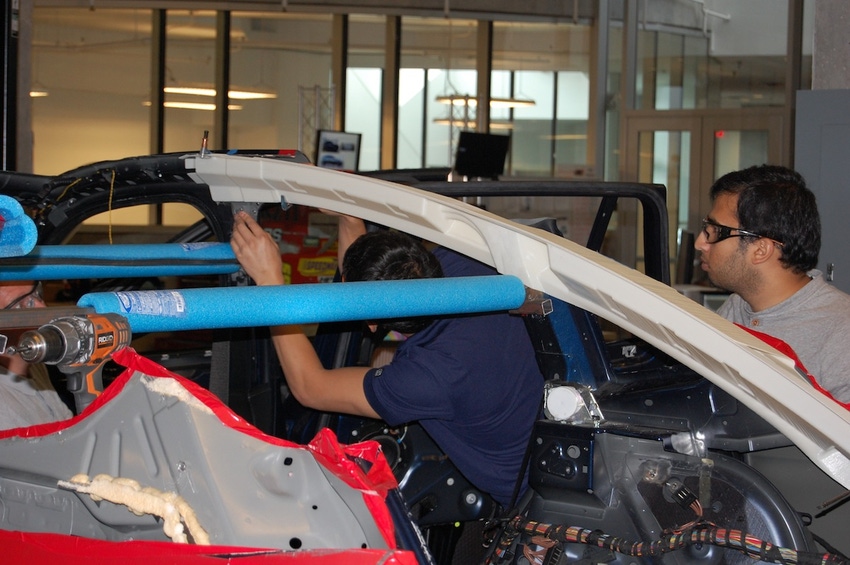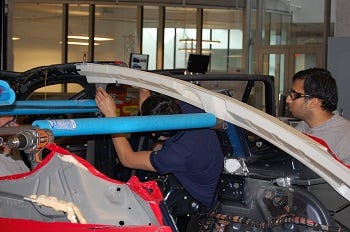Polyurethane-base adhesives, foams contribute to vehicle lightweighting
Dow Automotive Systems (Auburn Hills, MI) has partnered with the Deep Orange 4 team at Clemson University's (Clemson, SC) International Center for Automotive Research to support future automotive designers/engineers and highlight the broad Dow Automotive Systems portfolio of lightweighting products. The resulting concept vehicle was unveiled this week at the Center for Automotive Research Management Briefing Seminar in Traverse City, MI.
August 7, 2014

Dow Automotive Systems (Auburn Hills, MI) has partnered with the Deep Orange 4 team at Clemson University's (Clemson, SC) International Center for Automotive Research to support future automotive designers/engineers and highlight the broad Dow Automotive Systems portfolio of lightweighting products. The resulting concept vehicle was unveiled this week at the Center for Automotive Research Management Briefing Seminar in Traverse City, MI.
|
The BMW X3 gets a lightweighting makeover, with PU structural adhesives and foams lending a helping hand. |
|
Betamate polyurethane (PU) structural adhesives and Betafoam polyurethane (PU) structural foams from Dow Automotive Systems reportedly enabled design flexibility, added structural support, and bonded lightweight materials, in alignment with the student-run project goals. Dow Automotive Systems engineers also collaborated with the Deep Orange 4 team, providing application ideas and expertise in the area of lightweighting, mass reduction and structural support.
The Deep Orange 4 project is based on the BMW X3 and is defined as a versatile vehicle that targets the niche market of performance-oriented SUV customers who want both best-in-class utility/space and an aggressive sporty design. In addition, a cost-efficient manufacturing plan was developed to demonstrate how this low-volume derivative could be assembled without negatively impacting existing BMW production processes.
"We have been very pleased with the opportunities presented by this project," said Frank Billotto, Commercial Transportation Industry Manager, Dow Automotive Systems. "It's been inspiring to work with bright minds, a forward-looking program and all of the challenges that come with creating concept vehicles. This program gives students hands-on experience with real-world vehicles and industry experts, which is very beneficial to the industry as a whole. We look forward to our next venture with the Deep Orange program.
"The team from Dow Automotive brought us materials and know-how that proved to be very valuable," said Suzanne Dickerson, Director of International Business Development at CU-ICAR. "The structural adhesives and structural foam materials that they supplied gave the team a real-world understanding of lightweighting issues and solutions."
The X3 derivative incorporates several design revisions compared with a stock X3. For example, the sliding glass roof provides one of the largest openings of all competitive SUVs, transforming the trunk compartment from an enclosed area into an open-bed configuration with the utility of a pick-up truck. The roof was engineered to integrate the BMW X3 panoramic roof module into the existing vehicle body structure and, in combination with glass over the passenger compartment with sporty styling, results in a seamless overall vehicle design.
The interior includes several design elements customers would expect in any BMW product. A window mechanism is located behind the rear seats to seal the cabin and protect passengers from adverse weather and driving conditions when the vehicle is in the truck mode. Customers can use the HVAC system even while driving with the window in its open-bed configuration. Additionally, this window mechanism will fold completely flat to allow more cargo space. The rear seats were designed to provide a flat load floor, accomplished by two parts swiveling and then resting on the front seats. Also, the trunk compartment is trimmed with real wood and waterproofed to further enhance the luxury appeal of the interior
To enable access to the open trunk space for larger cargo, the rear hatch in the BMW X3 was replaced by two doors which open using a unique hinge mechanism that both functional and aesthetic. In addition, the tailgate houses the retractable part of the panoramic roof.
Instead of using traditional metal parts and die technology which is expensive and has long lead times, the build of the entire upper part of the prototype vehicle was completed using 3D rapid prototype FDM parts from Redeye on Demand (Eden Prairie, MN).
About the Author(s)
You May Also Like



